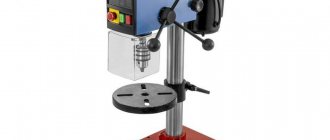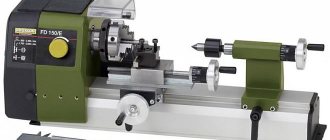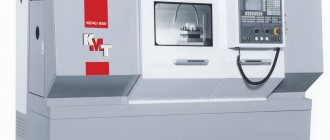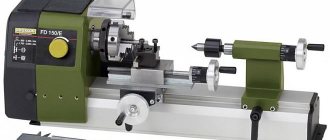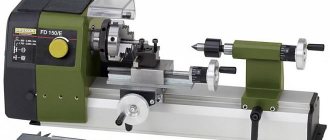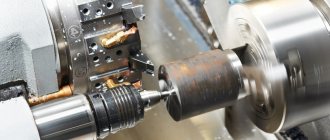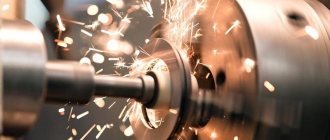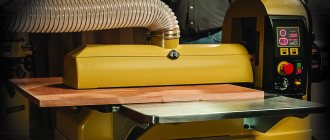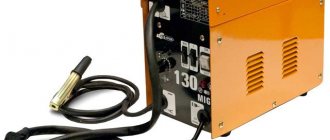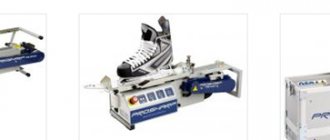To grind, cut and sharpen metal products with your own hands, it is not necessary to work as a turner, because it is enough to purchase a metal lathe for your home and make all the necessary workpieces in your personal workshop. The quality, speed of production of parts, ease of use of the tool - all this will be at the highest level if you choose it wisely and do not neglect the operating recommendations.
What a mini lathe can do
A tabletop metal lathe, the only one that can easily be placed in your own garage, is a smaller copy of a factory tool. For the most part, differing only in size, the home unit “can do” almost everything:
- Grind parts;
- Trim the edges of metal blanks;
- Grind surfaces;
- Drill holes of various diameters;
- Expand the bases;
- Cut threads inside and outside.
place
| Ø processing above the bed | 180 |
| RMC | 300 |
| Max. rpm | 2500 |
| Power, kWt | 1.00 |
| Voltage | 220V |
| Weight, kg | 55 |
The JET BD-7VS desktop lathe is designed for processing metal and other materials by turning with the ability to cut right-hand threads, both metric and inch. The machine is supplied with a three-jaw chuck; a set of return jaws is available separately. In a special tool box there is a set of replacement gears, they are in
Full description …
Advantages and disadvantages of the mini option
Compared to its workshop counterpart, a mini metal lathe is designed to work with small parts. This is just one of the advantages of a home tool, and the list continues with the following points:
- Compactness;
- Easy to use;
- High quality;
- Sufficient power supply from a 220 Volt network;
- Low energy consumption costs;
- Light weight;
- Possibility of additional equipment.
However, there are also some “disadvantages”:
- Significantly lower operating speed;
- Restrictions on use (small workpieces only).
"Turning" technical parameters
The appearance of this tool can be seen in the photo of a metal lathe. But regardless of the body material and equipment, the unit is evaluated according to the following performance characteristics:
- Device weight;
- Productive capacity;
- The number of revolutions performed per minute;
- Height of "centers";
- Maximum dimensions of processed parts;
- Number of switchable speed modes.
Read here: How to choose wire for welding - a review of the best types and advice from professionals on choosing
It is also important to pay attention to the material of the body and sharpening elements, the possibility of additional equipment, and design.
Comparison table of characteristics
It will be more convenient for you to compare the described models by looking at the general table with the main characteristics.
| Model | Purpose | Dimensions | Weight | Revolutions | Power | Max diameter |
| Proma DSO-1000 | woodworking | 1450x250x370 mm | 29 kg | 850, 1250, 1750, 2510 | 400 W | 350 mm |
| Belmash WL-300/450 | woodworking | 965x370x420 mm | 32 kg | 430, 750, 1150, 1800, 2800 | 550 W | 305 mm |
| Encore Corvette-73 | woodworking | 1485x230x370 mm | 27 kg | 810, 1180, 1700, 2480 | 350 W | 350 mm |
| Caliber STMN-550/350 | for metal | 815x368x385 mm | 40 kg | 0-2500 | 550 W | 180 mm |
| Kraton MML-01 | for metal | 695x310x305 mm | 38 kg | 50-2500 | 500 W | 180 mm |
| Jet BD-X7 50000900MX | for metal | 720x300x290 mm | 55 kg | 0-2500 | 750 W | 110 mm |
| Bison ZSTD-350-1000 Master | woodworking | 1470x350x340 mm | 29 kg | 810-2480 | 350 W | 350 mm |
How to choose the right one
When choosing a suitable tool, you need to “try on” the necessary queries against the listed parameters. The following recommendations will help you make the right decision:
- The home version usually weighs no more than fifty kilograms, and the power of the unit varies from 0.15 to 3 kW.
- It is better to decide in advance on the scope of work to be performed so as not to overpay for unnecessary functions and capabilities.
- Make sure that the machine elements are polished.
- Calculate the frequency of use (for frequent work it is better to choose semi-professional models).
- Pay attention to the manufacturer (Swiss is considered the best).
- Choose a device with a CNC system.
Engine selection
When purchasing a finished machine, you need to pay special attention to the engine. The existing engine fully corresponds to the description in the instructions, which specify the permissible loads. First you need to decide on the needs and area in which the machine will be used.
Asynchronous
An induction motor is designed to convert alternating current electrical energy into mechanical energy. The name of this motor includes its purpose, “asynchronous” means “non-simultaneous”.
It is indicated that in asynchronous motors the rotation frequency of the stator magnetic field always exceeds the rotor rotation frequency. The operation of an asynchronous motor occurs from an alternating current network. The induction motor has either an aluminum or cast iron frame. The stator winding is located in the slots of the stator core.
The ends of the winding phases are brought out through a hole in the frame into a box, which consists of a housing, an adapter pipe and a cover. This class of engines has a wide power range. They are chosen mainly because they have high power with relatively small sizes, the rotation speed is high, and asynchronous motors are reliable.
Collector
The commutator motor assumes in its design a rotor position sensor and a current switch in the windings, which is one and the same device - a brush-commutator unit.
An electric current entering the armature windings provokes the appearance of an electric field, which, on the one hand, has a south pole, and on the other hand, a north pole. The current through the windings gradually passes from one winding to another, the motor shaft rotates together with the armature, but only as long as voltage is supplied to it.
How to do it yourself
You can save on buying a device and make the machine yourself, which will require finding many stainless steel components with a thickness of at least 3 cm (for supporting parts). The main thing is to pay attention to reliability
- Calipers (needed for fastening, moving and fixing);
- Statins (supporting element).
Not everyone can cope with such a task, so it is recommended not to experiment, but to trust trusted manufacturers.
How to operate the machine
The instructions for a metal lathe vary depending on the type and focus of the work, but the general rules can be formulated as follows:
- Take a course on how to use the device.
- Personal protective equipment must not be neglected.
- The caliper must be used reliably.
- Start with the simplest operations and low speeds.
- Make sure that the electrical network can handle the load.
To become a turner, you need to purchase a suitable and reliable tool that allows you to easily and efficiently perform all assigned tasks.
The main thing is that before choosing a lathe for your home, decide in advance on the desired dimensions and range of work to be performed, after a successful purchase, read the attached instructions, and during the process, follow safety precautions.
Tips for choosing
- Purpose. There are machines for processing wooden blanks or metal and plastic parts.
- Reliability. The frame guides must have high-quality fasteners, as they are responsible for the stability of the entire structure and reduce vibration during operation.
- Material. The bed experiences enormous loads, so it must be made of cast iron.
- Mains voltage. If the machine is installed at home, make sure that the electrical wiring can withstand its connection.
- Speed. At all speeds declared by the manufacturer, the device should operate without interruption.
- Workpiece dimensions. Each model has a maximum length and diameter of the workpiece that can be processed on it.
